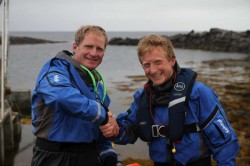Second time lucky as kayak pair become first to paddle across North Sea
Two adventurers became the first to cross the North Sea by kayak this summer, when they paddled from Shetland to Norway.
Patrick Winterton and Olly Hicks set off from Skerries early in the morning of the 17th July, in a two man kayak, bound for Bergen.
This was their second attempt to make the crossing, after being forced to abandon a previous journey in 2011 because of bad weather and deteriorating sea conditions.

This time though, the weather was mostly on their side.
“We were expecting to take at least 72 hours” said Patrick Winterton, “just judging by previous trips and average speeds … But with the weather conditions we were a whole lot quicker than expected.
“The best wind you can have is behind you from the side, south-westerly. We were heading on a due east course, so south-westerly wind is your optimum. We had that on the first day, and we averaged something ridiculous like 4.8 knots for 18 hours. Most sailing boats would be happy with that I think.”
On the second day, however, things weren’t quite so good. “The wind switched to westerly, which most people would think is even better. But actually a following sea is very difficult to paddle in because your rudder spends most of its time out of the water, so when the wave comes up behind you it actually picks the back of the boat up … Day two in particular we had 18 hours of that, which was exhausting, and your speed ranges from zero to seven or eight knots and then back to zero again, so you spend your whole time accelerating and decelerating, which is not ideal when you’re feeling particularly seasick anyway.”
Patrick said that during the first 48 hours of the journey, the wind stayed between force four and six, which makes for a heavy sea in a kayak.
“The North Sea’s notorious for nasty steep waves” he said, “and on the second day we were being hit by broken waves certainly every ten minutes or so.”
The seasickness that afflicted Patrick was another serious hindrance, though given the conditions it was not exactly a surprise.
“Grey sea, grey sky, visibility at 400 metres, no horizon: I knew I was going to get it at some stage. So I was actually quite glad I got through to the first night before it happened. From the first evening I think I had one Jaffa cake in the next 48 hours.
“Actually the food isn’t a problem because you have enough reserves, but the liquid is. My main concern was [avoiding] getting to a state of dehydration where you just can’t work. And that actually focuses your mind more than the waves.
“Once we got within 30 miles of Norway, the weather improved. And once you can see a horizon the seasickness vanishes altogether. So I actually felt fantastic on day three.”
All in all it took 62 hours for the pair to reach land, where they rested overnight before continuing toward Bergen the following day.
This was a real achievement: the first crossing of the North Sea by kayak. But, said Patrick, the real pleasure was in the planning.
“The main things that you get out of it is not so much the journey and it’s not so much the sense of achievement – it’s the fact that you spent a couple of years of your life with a real focus and just trying to work out how you do it.
“It’s easy to do something that’s been done before because you just read how the people before did it, but if you’re trying to do something that’s never been done before you sort of have to get in your shed at home and work out your own systems: the buoyancy system, the sleeping system – everything was just sort of Heath Robinson, homemade. And because of that it’s enormously satisfying when it actually works and you don’t have to go home with your tail between your legs.
“The build up to the trip and the thought processes that go into it are by far the most memorable and the most rewarding, compared with the actual journey itself, which was pretty unpleasant.”
First and foremost this was a personal challenge for Patrick and Olly. They wanted to make the crossing because they believed it was possible and because no one had done it before. But there was, too, a fundraising element to the voyage, with money going to the RNLI and Make A Wish Foundation.
Ironically, until only a few days ago, the couple had raised more from their failed trip in 2011 than they had on this successful voyage. “There’s a moral there somewhere” said Patrick. However, the money is continuing to come in, anyone who wishes to donate can do so by visiting their website www.kayaks onshetlandbus.org.



NO COMMENTS
Add Your Comment